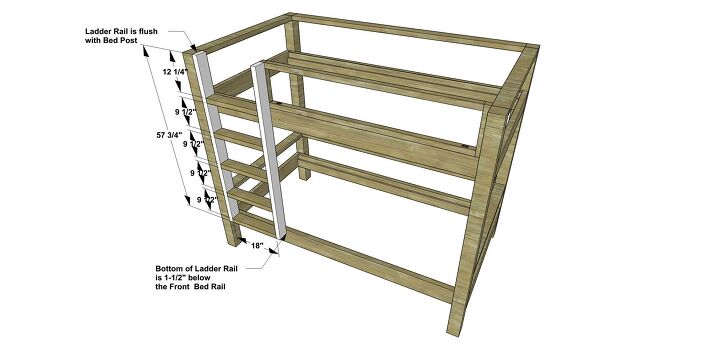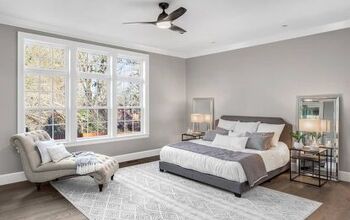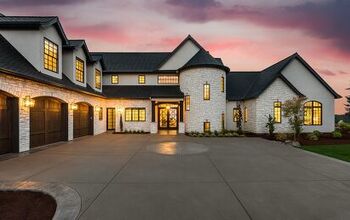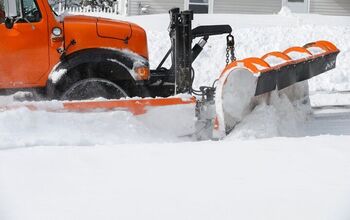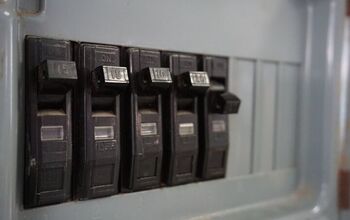Bunk Bed Ladder Plans (with Drawings)

Bunk beds are great solutions for adding extra sleeping space in close quarters, especially kid’s rooms, dorms, and camp retreats. You get twice the sleeping area within the same footprint, although admittedly, sleeping on a bunk isn’t for everyone. Of course, for many kids, the only dilemma often becomes about who will get to snag the top bunk.
To reach that often coveted top bunk, you need a bunk bed ladder, and they come in various styles. The average size of a standard bunk bed ladder is roughly 58 to 60 inches tall and about 16 to 18 inches wide. Additionally, there should be about 10 to 12 inches of space between each rung on the ladder.
Of course, the resulting size will rely significantly on the size of the bunk beds, as will the ladder’s location. Typically, you’ll find them on the side or end of the bunks, either straight or leaning at a slight angle. Overall, you want a ladder that fits securely onto the bunk and allows for easy access to the top bed.
Determining the Size of a Typical Bunk Bed Ladder
The standard set of bunk beds usually features two stacked twin size beds. Therefore, typical bunk beds are usually about 75 inches long and 39 inches wide. The biggest factor for determining ladder size though is the height of the bed, which is usually around 65 inches.
The ladder usually isn’t as tall as the bed since it only reaches the bottom of the top bunk. Therefore, the average height of a typical bunk ladder is between 58 and 60 inches tall. If you plan to have the ladder lean out slightly, then it may be somewhat longer.
For your ladder width, the typical size is between 16 to 18 inches wide. However, in some cases, the width can be larger. For example, if your ladder is at the foot of the bed, it could take up the entire width and be closer to 39 inches wide.
Consider the Clearance for the Bunk Bed Ladder
Before deciding if your ladder will attach to the bed at the top and bottom or lean out, know your available floor space. Obviously, a ladder that comes out at an angle could potentially make your overall width of the beds about one to two feet wider in that spot. The less floor space the angled ladder takes up, the steeper the angle.
Ideally, you’ll have about 30 inches of space next to the bunk bed to make getting in and out easy. Don’t have a lot of space next to the bed? Consider if placing a ladder at the foot is the better way to go.
Pay Attention to Bunk Bed Ladder Rungs and Spacing
A critical dimension when dealing with bunk bed ladders is the spacing between the rungs. Put them too close together, and it becomes difficult to climb and could lead to injury. Conversely, putting them too far apart can also lead to injury.
A good rule of thumb is to space the rungs out about 10 inches for children’s bunks and about 12 inches max for adults. If you’re building a bunk ladder yourself, also pay attention to the type of wood you use for the rungs. This isn’t a place you want to skimp.
The rungs need to support a person’s body weight easily, therefore at a minimum, opt for sturdy 2 x 4s.
Different Bunk Beds Call for Different Ladders
Of course, although twin bunks are the most common style of bunk beds, there are several other options. Each option calls for a slightly different size ladder.
Toddler Bunks and Ladders
These bunks are smaller and fit two crib-size mattresses. The bunks are about 30 inches wide and about 60 inches high. However, the ladder only needs to be roughly 48.5 inches tall since it reaches to the bottom of the top bunk.
In this example, 30-inch rungs span the entire width of the bed, making it easy for kids to manage.
Other examples of when you might need a smaller ladder are junior loft beds. They can be similar in size to this toddler bed version of bunks or feature a twin-size mattress.
However, since it’s a loft, there is no bottom bunk, just the upper bed with empty space below. Therefore, for a junior loft, you would need a junior bunk ladder. These ladders are typically about 44.5 inches tall and between 13 and 16 inches wide.
Taller Bunk Beds and Ladders
Kids are often the users of bunk beds, but teens can also use them, as can adults. Bunk beds are often a staple feature in cabin retreats and bunkhouses, hence the name. But, with adults, more headroom on the bottom bunk is often appreciated.
Therefore, these bunk beds might be slightly taller than your average bunk, although they still fit two twin mattresses. A taller bunk can be closer to about 75 to 80 inches high. Therefore, it requires a ladder that needs to be between 66 and 71 inches tall. The ladder width typically is the same as an average ladder.
One thing to keep in mind if opting for a taller bunk or loft bed is the ceiling height. Make sure you have enough clearance between the top of your top mattress and the ceiling.
While being able to sit up comfortably is ideal, it’s not always possible. This usually requires about 33 to 36 inches of space between the ceiling and the top of the mattress.
Therefore, just make sure someone can turn over in bed without bumping their head on the ceiling. Usually, a headspace of about 2 feet is the minimum.
Custom Bunk Beds and Bunk Bed Ladders
In some cases, you might end up building or purchasing a custom set of bunk beds. Since the bed is not a typical size, a standard bunk bed ladder won’t do. Therefore, plan on building or purchasing a custom-made bunk bed ladder as well.
Ultimately, the top of the ladder should reach at least the base of your topmost bunk. If the ladder needs to attach to the bunk’s rail, then it needs to be longer to reach the rail.
You could have a custom ladder that’s up to 95 inches long or more if you need it to be. Some people even have triple bunks in which they use one long ladder and one shorter ladder, like below.
The length of your bunk bed ladder is the factor that will change the most for various bed styles. However, it’s not the only consideration.
Remember that the rung spacing should fall between 10 and 12 inches. Otherwise, choose a width that feels right for you and works with your bed’s style.
Considering the Location of the Bunk Bed Ladder
Of course, you need to consider several aspects of your space when deciding on the bunk bed ladder’s location. For example, if the ends of the bunk are between two walls, don’t use a ladder built-in to the foot. Likewise, if your floor space is limited, use a perpendicular style ladder instead of one that’s on an angle.
Also, make sure the ladder doesn’t interfere with any doors that need to open, etc. Additionally, ensure there is enough room between the ladder and any nearby furniture.
Using Steps or Stairs for Your Bunk Beds
For some setups, especially with small children, parents might feel more comfortable using bunk stairs instead of a ladder. Bunk stairs are typically wider than ladders and span the whole width of the bed since they’re on the end.
The rise is similar to the spacing of the rungs, usually around 10 inches tall. The most significant factor to keep in mind if using bunk stairs is the extra room they take up in your space. On average, they can potentially add about another 18 to 30 inches to your bed’s overall length.
Besides being easier to climb, an added benefit to using stairs is they can add storage potential. Many stairs feature steps that lift up or built-in drawers, perfect for storing clothes, toys, and other odds and ends.
Related Questions
Do you use the same mattress in a bunk bed that you use in a standard bed?
Typically, it’s acceptable to use regular mattresses in a standard bunk bed. The only extra consideration is you need to pay closer attention to the thickness of the mattress. Concentrate on mattresses that are around 8 inches to avoid losing too much space between your top mattress and the ceiling. Also, it’s not advisable for the top mattress to go above the top rail for safety purposes.
Can I stack regular twin beds?
No. Stacking beds that aren’t meant to work as bunks is very dangerous. Bunk beds are specifically made to fit into each other or secure to each other in some fashion.To avoid potential collapse, always use actual bunk beds as bunks. If you think you might want separate beds one day, many bunks can be split.
What if I don’t want my kids climbing on the bunk bed ladder?
In some households, older kids use bunk beds, but there are smaller children in the house. These smaller kids can get hurt trying to climb the ladder. If this applies to you, there are special bunk bed ladder barriers you can get.These covers go on the ladder when it’s not used to prevent younger children from climbing them. For example, when your older kids are at school, do you need a way to keep your two-year-old from climbing? Then a ladder cover can provide an extra layer of protection. Additionally, there are ladder rung covers that can provide more comfort and a non-slip surface. This can make climbing the ladder safer and comfier for your kids who are supposed to use it.
Related Articles

Stacy Randall is a wife, mother, and freelance writer from NOLA that has always had a love for DIY projects, home organization, and making spaces beautiful. Together with her husband, she has been spending the last several years lovingly renovating her grandparent's former home, making it their own and learning a lot about life along the way.
More by Stacy Randall




